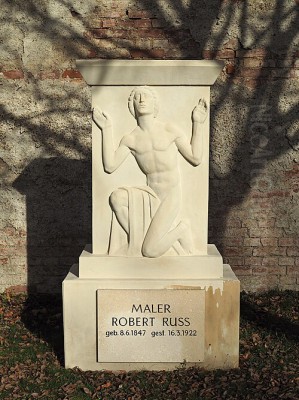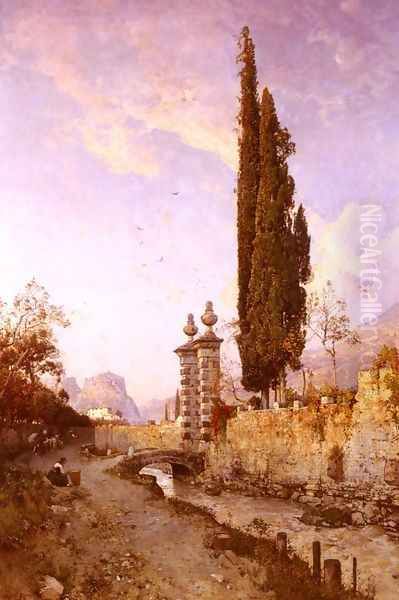
Robert Russ (1847-1922) stands as a significant, if sometimes overlooked, figure in Austrian art history. A dedicated painter of landscapes, his career spanned a transformative period in European art, witnessing the zenith of academic traditions and the revolutionary rise of Impressionism and Post-Impressionism. Born and deceased in the imperial city of Vienna, Russ carved a niche for himself with his evocative depictions of nature, his keen observation of atmospheric effects, and his evolving experimentation with color and light. His work offers a fascinating window into the Austrian artistic milieu of the late 19th and early 20th centuries, a period of immense cultural ferment and innovation.
Vienna's Artistic Crucible: The Formative Years
Robert Russ was born in Vienna in 1847, a city that was then the vibrant capital of the Austro-Hungarian Empire. This environment was rich with artistic and cultural institutions, including the esteemed Academy of Fine Arts. While specific details of his early training are not always exhaustively documented in popular accounts, it is typical for aspiring artists of his generation to have sought formal instruction. The prevailing artistic tastes in Vienna during his formative years were largely shaped by Historicism, particularly evident in the grand architecture of the Ringstrasse, and a strong academic tradition in painting, often favoring meticulous detail and grand historical or mythological themes. Painters like Hans Makart were dominant figures, known for their opulent and theatrical compositions.
However, the seeds of change were being sown across Europe. The Barbizon School in France had already championed direct observation of nature, and by the time Russ was establishing his career, Impressionism was making its radical debut in Paris. It is within this dynamic context of established tradition and emerging modernism that Russ's artistic identity began to take shape. His early works, while perhaps more grounded in traditional techniques, already hinted at a profound connection to the natural world.
The Impressionist Current and Beyond

Robert Russ's artistic journey is most compellingly understood through his engagement with the principles of Impressionism and, subsequently, elements of Post-Impressionism. Active primarily between 1880 and 1910, his work reflects a deep interest in capturing the fleeting effects of light and atmosphere, a hallmark of Impressionist painters like Claude Monet, Camille Pissarro, and Alfred Sisley. Russ was particularly adept at rendering the subtle nuances of daylight, the changing seasons, and the specific character of the Austrian and Alpine landscapes he so frequently depicted.
His approach often involved a brighter palette than that of his more academic predecessors, and a looser brushstroke that aimed to convey sensation rather than photographic detail. This is evident in his treatment of foliage, water, and sky, where forms might be suggested rather than sharply defined, allowing the viewer's eye to blend colors and perceive the overall luminous effect. While perhaps not as radical as some of his French contemporaries, Russ's interpretation of Impressionist ideals was distinct and personal, filtered through an Austrian sensibility.
Later in his career, one can observe an evolution that touches upon Post-Impressionist concerns. This included a more structured approach to composition at times, and a continued, perhaps even intensified, exploration of color theory. The mention of "color experiment" and "pointillist techniques" in relation to his work suggests an awareness of artists like Georges Seurat and Paul Signac, who scientifically explored optical mixing. Russ’s adaptation of these techniques would have been his own, likely integrated into his landscape paintings to enhance their vibrancy and atmospheric depth. His style was described as moving from an earlier, more "solid and decorative" phase to a later one that was "more abstract and dreamlike," indicating a progressive artistic development.
Signature Canvases: Capturing the Austrian Soul
Several works by Robert Russ are cited as representative of his oeuvre, each offering insight into his artistic preoccupations. Mill in South Tyrol, painted in 1875, is a significant piece, now housed in the prestigious Leopold Museum in Vienna. This painting likely showcases his ability to blend architectural elements with the natural landscape, capturing the rustic charm and specific light conditions of the Alpine region. The South Tyrol, with its dramatic mountains and picturesque valleys, provided ample inspiration for landscape painters.
Gebirgsbach dem Gewitter (Mountain Stream before the Storm), dated 1891, powerfully evokes a sense of impending drama in nature. One can imagine Russ skillfully depicting the darkened sky, the agitated waters of the stream, and the charged atmosphere that precedes a thunderstorm. Such a subject allowed for expressive use of color and dynamic composition, characteristic of the Romantic landscape tradition but reinterpreted through a more modern, Impressionistic lens.
By the Fountain, created around 1910, suggests a more tranquil, perhaps idyllic scene. Fountains in gardens or village squares were popular motifs, offering opportunities to explore the play of light on water, the textures of stone, and the human element within a landscape. The fact that this painting fetched €18,200 at a 2024 auction indicates a continued appreciation for his work in the art market. Other titles, such as Courtyard of Prince Burggis's Castle (1871) and Northern Landscape, further illustrate the breadth of his landscape subjects, from historic architecture integrated into nature to broader, more atmospheric vistas.
Exhibitions and Recognition: An Artist on the European Stage
Robert Russ was an active participant in the art world of his time, and his works were featured in numerous significant exhibitions across Europe. This exposure was crucial for an artist's reputation and commercial success. The Künstlerhaus in Vienna, a major association for Austrian artists, served as a frequent venue for showcasing his paintings, with documented exhibitions in 1891 and a posthumous showing in 1923. His presence there underscores his standing within the Austrian art community.
His reach extended beyond Austria's borders. In 1891, he also exhibited at the Internationale Kunstausstellung in Berlin, a testament to his growing international recognition. The following year, 1892, saw his work displayed at the IV Internationale Kunstausstellung in the Glaspalast (Glass Palace) in Munich, another prominent center for art in the German-speaking world. Further afield, Russ participated in Le Salon in Brussels in 1896, placing him in the company of a diverse range of European artists. In 1897, he exhibited at the Internationale Kunstausstellung in Dresden.
The inclusion of his works in such varied and prestigious exhibitions highlights the appeal of his art and his engagement with the broader European artistic discourse. While the provided information also mentions his works being shown in major international museums like MoMA, Centre Pompidou, and the Tate, these are more likely general statements about artists of his caliber or posthumous acquisitions and retrospectives rather than exhibitions during his lifetime, with the Leopold Museum being a confirmed holder of his work.
Contemporaries, Students, and the Düsseldorf Echo
Robert Russ did not operate in an artistic vacuum. He was part of a vibrant generation of Austrian artists and also had connections, whether direct or stylistic, to broader European movements. Among his students were several painters who went on to achieve recognition in their own right. Emil Jakob Schindler (father of Alma Mahler) was a particularly notable student, himself becoming a leading figure in Austrian atmospheric Impressionism (Stimmungsimpressionismus). Other students included Eugen Jettel and Rudolf Ribarz, who would have absorbed aspects of Russ's approach to landscape and light. Alois Arnegger, another student, became known for his romantic and often sun-drenched depictions of Italian coastal scenes, carrying forward a love for landscape.
In the wider Austrian context, Russ was a contemporary of artists who would define Viennese modernism, such as Gustav Klimt, Egon Schiele, and Oskar Kokoschka, though Russ's primary focus remained landscape painting within an Impressionistic framework rather than the more radical figurative explorations of the Secessionists. Other notable Austrian landscape painters of the era included Tina Blau and Olga Wisinger-Florian, who, like Russ, embraced Impressionist techniques to capture the Austrian scenery. Carl Moll, a Secessionist, also produced significant landscapes.
An interesting stylistic connection mentioned is to the Düsseldorf School of Painting. This German school, prominent in the mid-19th century, was known for its detailed, often romantic and dramatic landscapes, exemplified by artists like Andreas Achenbach and Oswald Achenbach. If Russ's earlier work showed "solid" and "decorative" qualities, it might reflect an influence from the meticulousness and compositional structures favored by the Düsseldorf tradition, which he would have later synthesized with the looser, light-focused techniques of Impressionism.
While the provided information does not detail specific collaborations or intense rivalries with major international figures like Vincent van Gogh or Paul Gauguin, Russ was undoubtedly aware of their work and the broader Post-Impressionist currents. His engagement with pointillism, for instance, shows an artist receptive to new ideas, adapting them to his own vision.
A Life Dedicated to Art: The Absence of Anecdote
Interestingly, the available information notes a lack of "sensational" anecdotes or highly unusual personal stories directly associated with Robert Russ the painter. This is not uncommon for artists who may have led lives more focused on their craft than on cultivating a flamboyant public persona. The art world has its share of colorful characters, but many great artists are known primarily through the legacy of their work.
The absence of such tales might suggest a personality dedicated to the patient observation of nature and the meticulous, yet inspired, translation of those observations onto canvas. His commitment to landscape painting, a genre that often requires solitude and deep immersion in the environment, points to a life perhaps lived with a quieter intensity. His legacy, therefore, is not built on eccentricities but on the consistent quality and evolving vision present in his paintings. He was not, for instance, the Robert Edwin Russ associated with the founding of Ruston, Louisiana, nor connected to unrelated historical curiosities sometimes brought up by broad name searches. His story is firmly rooted in the art history of Austria.
The Enduring Legacy of Robert Russ
Robert Russ's contribution to Austrian art lies in his sensitive and skilled interpretation of the landscape through an Impressionist and Post-Impressionist lens. He successfully navigated the transition from 19th-century academic traditions to more modern modes of expression, developing a personal style that captured the unique beauty and atmosphere of Austria and its surrounding regions. His dedication to plein air principles, his exploration of light and color, and his ability to evoke mood place him among the important landscape painters of his generation.
His works continue to be appreciated, as evidenced by their presence in museum collections like the Leopold Museum and their performance in the art market. He played a role in shaping the next generation of Austrian painters through his teaching, with students like Emil Jakob Schindler becoming influential artists themselves.
While perhaps not as globally renowned as some of the leading French Impressionists or the groundbreaking Viennese Secessionists, Robert Russ holds a secure place in the narrative of Austrian art. He represents a vital strand of landscape painting that embraced modern sensibilities while remaining deeply connected to the natural world. His paintings serve as luminous windows onto the Austrian terrain, filtered through the eyes of an artist who masterfully wielded light and color to convey not just a scene, but an experience. His dedication to his craft and his nuanced artistic vision ensure his continued relevance for those who appreciate the enduring power of landscape painting.